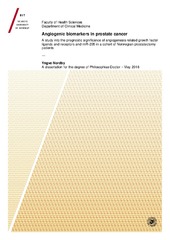Angiogenic biomarkers in prostate cancer - A study into the prognostic significance of angiogenesis related growth factor ligands and receptors and miR-205 in a cohort of Norwegian prostatectomy patients
Permanent lenke
https://hdl.handle.net/10037/13370Åpne
thesis introduction (PDF)
Nordby, Y., Andersen, S., Richardsen, E., Ness, N., Al-Saad, S., Melbø-Jørgensen, C., … Bremnes, R.M. (2015). Stromal expression of VEGF-A and VEGFR-2 in prostate tissue is associated with biochemical and clinical recurrence after radical prostatectomy. Also available in The Prostate, 75(15), 1682-1693. (PDF)
Nordby, Y., Richardsen, E., Rakaee, M., Ness, N., Dønnem, T., Patel, H.R.H., … Andersen S. (2017). High expression of PDGFR-β in prostate cancer stroma is independently associated with clinical and biochemical prostate cancer recurrence. Also available in Scientific reports, 7:43378. (PDF)
Nordby, Y., Richardsen, E., Ness, N., Dønnem, T., Patel, H.R.H., Busund, L-T., … Andersen, S. (2017). High miR-205 expression in normal epithelium is associated with biochemical failure - an argument for epithelial crosstalk in prostate cancer? Also available in Scientific reports, 7:16308. (PDF)
Entire thesis in one comprehensive file (PDF)
Dato
2018-05-03Type
Doctoral thesisDoktorgradsavhandling
Forfatter
Nordby, YngveSammendrag
Background: Prostate cancer is a heterogeneous disease, ranging from indolent and slow growing, to aggressive and lethal. Due to insufficient prognostic tools, there is a significant overtreatment of patients with harmless disease. Differentiating which patients benefit from radical treatments remains a huge challenge, and there is an urgent need to find new and better prognostic tools that may aid in treatment allocation. Angiogenesis is a well-studied hallmark of cancer. Without sufficient blood flow, the malignant tumor cannot grow to a selfsustaining tumor of significant size. The prognostic impacts of selected angiogenic biomarkers in our cohort were explored, with the aim to uncover novel biomarkers to contribute to the knowledge of prostate cancer aggressiveness for improved risk stratification. In addition, a deeper understanding of the molecular characteristics and functional pathways for different stages in prostate cancer is essential in order to succeed in development of novel therapeutic agents for targeted therapy.
Methods: Patient data and prostatectomy specimens from 535 Norwegian patients treated for prostate cancer with curative intent were collected. Using tissue microarrays with several cores from predefined areas of the specimens, staining with immunohistochemistry and in-situ hybridization were performed for renowned angiogenic biomarkers. Correlations between expression levels of biomarkers and clinicopathological varibles were explored, event-free survival times were calculated according to expression levels, and to assess their independent prognostic impact, the markers were entered into multivariate analyses.
Main results: High expression of vascular endothelial growth factor receptor 2 (VEGFR-2) or vascular endothelial growth factor A (VEGF-A) was independently associated with a higher incidence of prostate cancer relapse. High stromal expression of platelet derived growth factor receptor β (PDGFR-β) was independently associated with clinical relapse and biochemical failure. High expression of microRNA (miR)-205 in normal epithelium was independently associated with biochemical relapse.
Conclusions: We found positive associations between prostate cancer relapse and several biomarkers associated with angiogenesis. Especially PDGFR-β seems promising as a new biomarker as it outperforms traditional established prognosticators. A common finding for all three papers was that the prognostic impact of angiogenic markers was mostly found in tissue outside the actual tumor epithelium, highlighting the complex interplay in prostate cancer tumors. This may have implications for tissue sampling for research and in a therapeutic perspective, these pathways may also be attractive targets for targeted therapy.
Forlag
UiT The Arctic University of NorwayUiT Norges arktiske universitet
Metadata
Vis full innførselSamlinger
Copyright 2018 The Author(s)
Følgende lisensfil er knyttet til denne innførselen:


 English
English norsk
norsk
